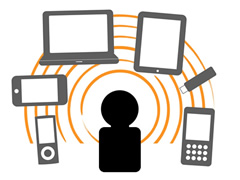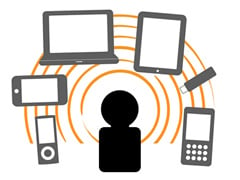
We’re used to thinking of corporate training happening in a classroom, or at the office in front of a desktop computer. But the proliferation of mobile devices—smart phones and tablets—has blasted through these old limits to where and when learning can take place. Not only can talent development now happen anywhere and anytime, but a company’s ability to attract and retain talent depends on it: in Futurestep Korn/Ferry’s June 2013 Innovation Imperative survey, 72% of job candidates indicated they expect employers to use innovative approaches to training—including mobile.
What will mobile training get us, that we’re not getting now?
People—workers—already learn on the go. They listen to language lessons while jogging. They skim news stories while in line at the coffee shop. They read professional association e-newsletters on
the train to work. Mobile devices have opened up these new windows of learning time. Making training content mobile-accessible simply acknowledges this fact, and lets workers engage with content in a format they’re already choosing to use. It also means they can learn on their own time—saving work time for actual work.
But mobile devices don’t just change out-of-office time. Workers also bring their mobile devices to work (ranging from 25% to 100% of workers in half of the 204 companies polled in a May 2013 ON24/Redshift Research survey). This development poses an enormous new opportunity for engaging workers. Even when not at their desks, just-in-time training, facilitated by the phone in their pocket, allows workers the ability to look up information or instructions for how to perform a task exactly at the moment they need it.
We don’t have the resources to add this new layer of complexity into our training program.
Actually, there is no added complexity—if the right tools are being used. This is the beauty of a well-implemented learning management system: it’s built to adapt content for use on any device, anywhere. For example, Totara LMS Mobile allows this kind of device-agnostic learning content distribution.
One adaptation that may be necessary to better harness mobile learning for workers is to acknowledge that content likely won’t be consumed all at once. It’s about context: people use their tablets or phones in potentially high-distraction environments (think of that coffee shop lineup), for only a few minutes at a time. They’re not sitting down to consume four hours of lessons, all at once. How to adapt? Make learning content consumable in bite-size chunks. Easy to put down and pick up again later. Bonus: this facilitates both actual engagement and retention, too.
Ultimately, the benefit to mobile training is that it puts workers in a position to integrate learning throughout their day. Companies benefit, but workers are wanting this too—their careers, no longer tied to the same unchanging role for decades, demand it. And really, it shows that the organizations they work for care about their contribution.
While providing mobile-ready talent development content is easy with a learning management system like Totara, encouraging workers to learn on the go is good policy: it enhances the perception of your employer brand, increases the timeliness and efficiency of your training programs, and it acknowledges—and respects–the way your workers are already choosing to learn.
Like to find out more about improving employee performance and engagement? Register for our March 27th Webinar.




